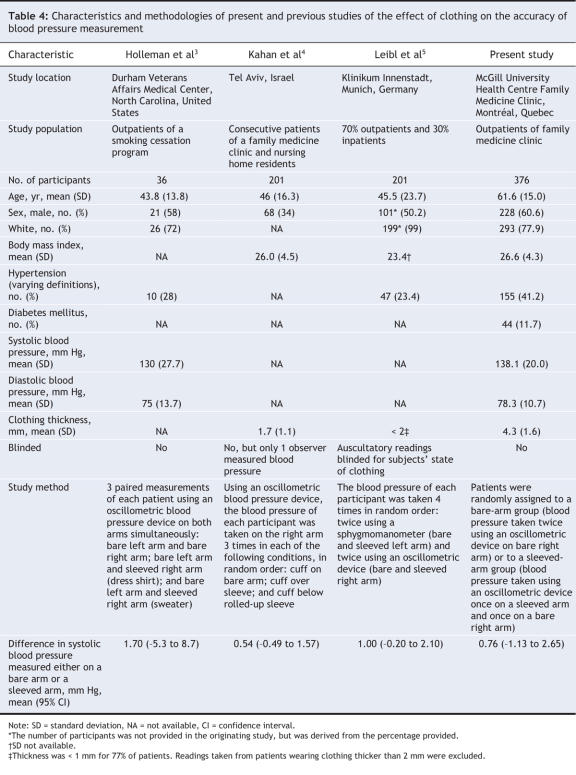Abstract
Background
The measurement of blood pressure is a common clinical exam with important health consequences. We sought to determine whether the measurement of blood pressure over a sleeved arm varies from that taken on a bare arm.
Methods
We recruited 376 patients between 18 and 85 years of age from a family medicine clinic between September 2004 and November 2006. They all had their blood pressure recorded using the same automatic oscillometric device, with the cuff placed over their bare arms for the first reading. Each patient was then randomly assigned to either the bare-arm group, for which the second blood pressure reading was also taken on a bare arm, or the sleeved-arm group, for which the second reading was taken with the cuff placed over the patient's sleeve.
Results
The mean age of the 376 participants was 61.6 years (standard deviation 15.0), 61% of the participants were male, 41% had hypertension and 11.7% had diabetes. We found no clinically important differences between the bare-arm group (n = 180) and the sleeved-arm group (n = 196) in age, sex or body mass index. The mean differences between the first and second readings for patients in the bare-arm group were 4.1 mm Hg (95% confidence interval [CI] 2.8 to 5.5) for systolic blood pressure and 0.1 mm Hg (95% CI –0.7 to 0.9) for diastolic blood pressure. The mean differences between the first and second readings for patients in the sleeved-arm group were 3.4 mm Hg (95% CI 2.1 to 4.7) for systolic blood pressure and 0.4 mm Hg (95% CI –0.4 to 1.3) for diastolic blood pressure. The between-group differences in these values was 0.76 mm Hg (95% CI –1.13 to 2.65) for systolic and –0.31 mm Hg (95% CI –1.48 to 0.86) for diastolic blood pressure; neither of these differences was clinically important or statistically significant.
Interpretation
We found that there was no significant difference in blood pressure recorded over a sleeve or on a bare arm. For practical purposes, the decision to measure blood pressure on a bare arm or over a sleeved arm should be left to the judgment of the health care professional taking the blood pressure.
The measurement of blood pressure is one of the most common examinations undertaken in family practice and has important health and management consequences for the patient. Accurate assessment of blood pressure, therefore, is very important. Current guidelines outline standards for obtaining accurate and reproducible blood pressure measurements.1 These standards include guidelines for the sizes of blood pressure cuffs and the position of the patient's arm, as well as a recommendation that the patient be seated for 5 minutes before his or her blood pressure is taken. In addition, it has been recommended that blood pressure be measured over the patient's bare arm.1 However, the current recommended method to determine blood pressure2 has several limitations (e.g., high variability of blood pressure at different times of day or if measured only once, loss of proper technique post-training).
Three previous studies have assessed whether blood pressure varies significantly when taken over a sleeved arm compared with a bare arm. Details of the literature review are described in Appendix 1, available online at www.cmaj.ca/cgi/content/full/178/5/585/DC2. In one study, involving 36 patients, Holleman et al3 found no significant differences in systolic or diastolic blood pressure readings taken over the sleeved or bare arm of each patient. However, this study was limited because of its small sample and because blood pressure measurements were taken on both arms simultaneously. A study by Kahan et al,4 involving 201 patients, compared blood pressure measurements taken over a sleeved arm, a bare arm and below a rolled-up sleeve. They found that the degree of clothing under the sphygmomanometer cuff did not have a clinically important effect on the reading. Although they found no significant difference in the effect of clothing on blood pressure readings, the study was limited by their design of measuring blood pressure below a rolled-up sleeve. The third study, conducted by Liebl et al,5 was published while our study was in progress. Their study, which involved 201 patients, compared blood pressure measurements taken over a sleeved arm and a bare arm with both sphygmomanometric and oscillometric devices. They concluded no significant difference in readings between the sleeved and bare-arm groups. In contrast to previous studies, we sought to determine whether the measurement of blood pressure over a sleeved arm varies from that taken over a bare arm through the use of a control group in which patients' blood pressure was taken only over a bare arm.
Methods
Study population
We recruited 400 consecutive participants from the McGill University Health Centre Family Medicine Clinic (Figure 1) between September 2004 and November 2006. Inclusion criteria were that the patient was between the ages of 18 and 85 years and had provided informed consent. We excluded patients who were unable to use their right arms (e.g., because of a fistula or injury) and patients whose sleeves ended at or above the elbows. Patients' clothing varied from shirts and blouses to thin cotton sweaters. Our prospective study was approved by the McGill University Health Centre Research Ethics Board.
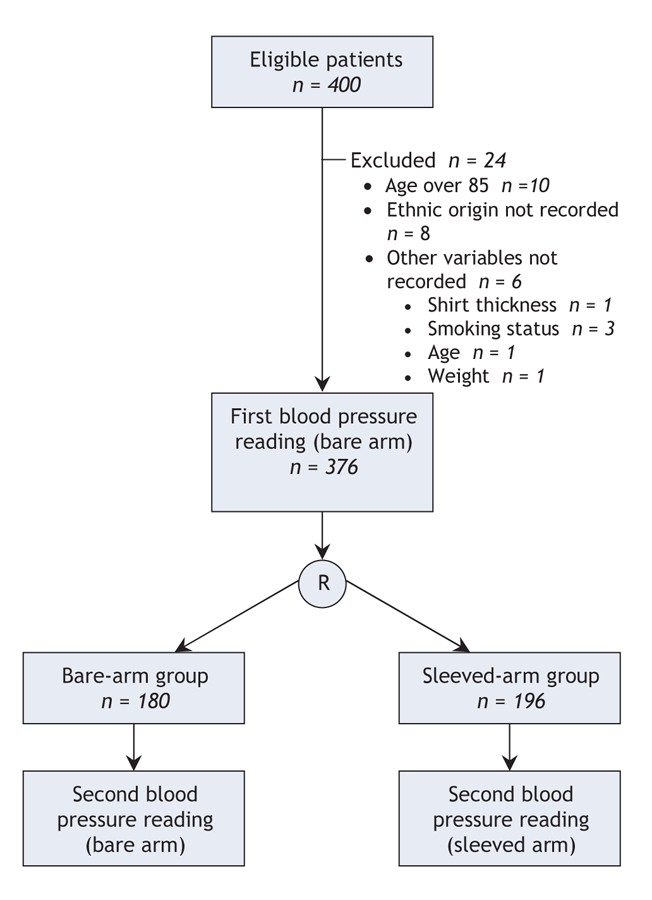
Figure 1: Selection of patients for the study. R = randomization.
During an interview with each participant, we recorded factors, such as age and sex, that might affect blood pressure. We measured each patient's height and weight using the same scale. The patient's sleeve was folded, and we measured its thickness in millimetres using a Holtain Skinfold Caliper.
Procedures
Participants were randomly assigned to have either both blood pressure measurements taken over a bare arm (bare-arm group, n = 180) or the first measurement taken over a bare arm and the second over the sleeve (sleeved-arm group, n = 196). The patients were seated for 5 minutes, with feet flat on the ground and back supported, before a clinical examiner measured their blood pressure using a commercially available automated blood pressure machine (LifeSource Blood Pressure Monitor Model UA-767CN, A&D Medical, San Jose). This device is approved by the Canadian Hypertension Society and validated according to the Association for Advancement of Medical Instrumentation protocol,6 and it has an accuracy of ± 3 mm Hg or 2%, whichever is greater. The same size of blood pressure cuff was used for each patient. One of 5 clinical examiners took 2 blood pressure measurements on the right arm of each patient. The first measurement was on a bare arm for both the bare-arm and sleeved-arm groups. Examiners waited 3 minutes between the first and second measurements in both groups. All 5 examiners (1 medical doctor, 2 nurses and 2 medical students) were trained to use the blood pressure machine.
Because of the nature of the study, blinding the participants, recruiter and examiners was not possible. The list of patients assigned to the bare-arm and sleeved-arm groups was kept on the nurses' computer.
We considered participants to be smokers if they smoked 1 or more cigarettes per day. We recorded whether patients had hypertension, diabetes, or high lipid levels if they were taking medication for those conditions.
Normally, blood pressure drops between the first and second readings. We hypothesized that readings taken over sleeved arms would be higher than those taken over bare arms. Thus, we expected the difference between the first and second readings to be lower for patients in the sleeved-arm group than for patients in the bare-arm group. Using StatsDirect,7 we estimated that a minimum sample size of 350 patients would be required to demonstrate a clinically important variation of 3 mm Hg (standard deviation [SD] 10, α = 0.05, β = 0.8) between the first and second readings for patients in the sleeved-arm group compared with those in the bare-arm group.
Statistical analysis
We used Student's t test to examine the overall difference between the mean blood pressure readings in both groups. We used analysis of covariance to assess the effect of any difference in method of first blood pressure reading and of potentially confounding variables, such as sleeve thickness, on the second readings in the 2 groups.
Results
Of the 400 participants recruited, we excluded 10 patients because they were older than 85 years, a further 8 patients whose ethnic origin was not recorded and a further 6 patients for whom other data were missing. We retained 376 patients for analysis. Of these, 41% had hypertension, 11.7% had diabetes, the mean age was 61.6 years (SD 15.0), and 61% were male. Characteristics of the study population are shown in Table 1. There were fewer patients with diabetes and more patients with high blood pressure in the bare-arm group than in the sleeved-arm group. There were no clinically important differences in sex, age, ethnic origin, body mass index or sleeve thickness between the 2 groups. The mean differences between the first and second blood pressure readings for patients in the bare-arm group were 4.1 mm Hg (95% confidence interval [CI] 2.8 to 5.5) for systolic blood pressure and 0.1 mm Hg (95% CI –0.7 to 0.9) for diastolic blood pressure. The mean differences between the first and second readings for patients in the sleeved-arm group were 3.4 mm Hg (95% CI 2.1 to 4.7) for systolic blood pressure and 0.4 mm Hg (95% CI –0.4 to 1.3) for diastolic blood pressure. (Table 2). The difference between first and second systolic pressure readings in the sleeved-arm group was lower than expected. The effect was a statistically nonsignificant between-group difference of 0.76 mm Hg (Table 2). The mean difference between the 2 groups when comparing the first and second diastolic pressure readings was –0.31 mm Hg (95% CI –1.48 to 0.86); this between-group difference was neither clinically important nor statistically significant.
Table 1
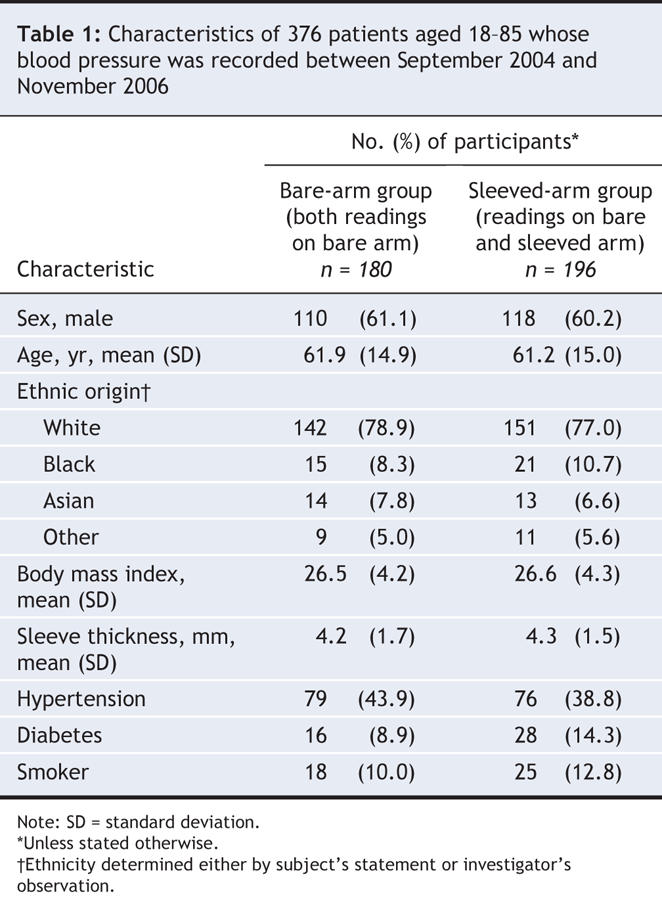
Table 2
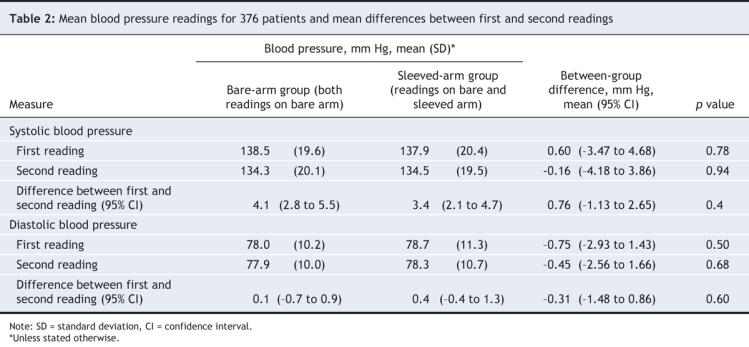
Among patients who had hypertension (n = 155), the difference in systolic blood pressure between the bare-arm group and the sleeved-arm group was 0.31 mm Hg (95% CI –3.1 to 3.71). Their first systolic blood pressure readings (mean 146.9 mm Hg) were significantly greater than the readings of patients whose blood pressure was normal (mean 132.0 mm Hg, p < 0.001).
Analysis of covariance (Table 3) showed that age and the first blood pressure reading were significant independent predictors of the second reading of systolic blood pressure. Whether the second blood pressure reading was taken over a bare arm versus a sleeved arm made no difference in this model. A similar evaluation of diastolic blood pressure also showed no difference between bare-and sleeved-arm readings.
Table 3
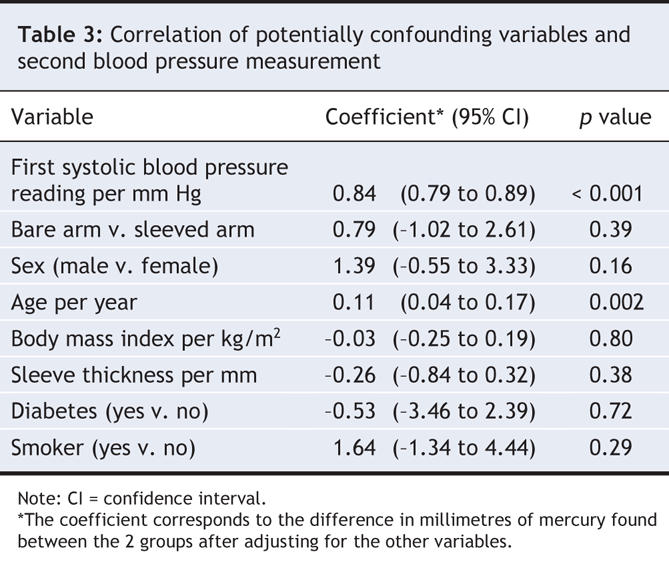
Sleeve thickness had no correlation with the difference between the 2 readings in the group (Pearson correlation coefficient 0.098, p = 0.469).
Interpretation
As we expected, our results showed that patients whose second blood pressure reading was taken over a sleeve had a smaller drop in blood pressure than patients whose second reading was taken on a bare arm. However, this difference was neither clinically important nor statistically significant. Our results confirm the findings of the 3 previous studies3–5 and show that, regardless of method, assessment of blood pressure over a bare arm and over a sleeved arm both yield accurate results. A comparison of the methodologies of all 4 studies is shown in Table 4.
Table 4
In our study, sleeve thickness was twice that in other studies; the increased sleeve thickness we observed may have been due to the folding of a loose sleeve of a shirt or top. The study by Liebl and colleagues5 excluded subjects with sleeves thicker than 2 mm. The other 2 studies did not specify exclusions based on the type of shirt. In addition, more patients were recruited in the colder part of the year and were likely to have thicker clothing than participants in either the study in Germany or in Israel.
Our study has a number of limitations. First, there were more patients with hypertension and fewer with diabetes in the bare-arm group than in the sleeved-arm group, but we found that neither hypertension nor diabetes affected the difference in blood pressure recorded for patients in either group. Second, we used only one blood pressure cuff size, which may have led to inaccurate readings in some patients. Third, examiners and patients were not blinded. To compensate, we used an automated device to minimize potential bias so that only a deliberate one-way error in copying the data from the blood pressure device to the database would have produced a significant effect. A further limitation was that the patients' blood pressure may have been affected by their own perceptions toward the effect of clothing on blood pressure. Although group assignment was not concealed from the recruiter, the amount of recruitment bias introduced by the potential lack of concealment was considered minimal, because patients in both the bare-arm group and the sleeved-arm group were required to remove their sleeved shirts for the first reading. Finally, blood pressure often falls as consecutive readings are taken.8 In contrast to previous studies, in which each patient had readings taken on a clothed and a bare arm, in random order, we used a different strategy of comparing results from a bare-arm group (both readings taken over bare arms) and a sleeved-arm group (readings taken over a bare arm and a sleeved arm). Although our strategy reduced the impact of the reduction in blood pressure, it introduced the problem of comparison among different individuals.
In an ideal world, we would all closely adhere to the guidelines for blood pressure measurement; however, we know that guidelines are not always followed, which leads to misclassification of patients.9 In reality, some patients may be uncomfortable taking off their clothing for a blood pressure measurement. Patients who do remove their clothing typically stand up, take their tops off, sit down and immediately have their blood pressure measured, rather than wait seated for the recommended 5 minutes. Perhaps it would be better to leave the patient with their clothing on for a minute, relaxed, and place the cuff over the sleeve to assess his or her blood pressure. In the end, it is the clinician's decision. The results of our study and previous studies indicate that we can now assure health care professionals that blood pressure readings taken over the sleeve are unlikely to vary significantly from those measured on a bare arm.
@ See related article page 591
Supplementary Material
Acknowledgments
We thank Panhavat Huor, Claudia Wong, Lily Chen and Marva Cunningham for their help in data collection. We also thank Panhavat Huor for her assistance in translating documents for the consent form and patient information sheet.
Footnotes
Une version française de ce résumé est disponible à l'adresse www.cmaj.ca/cgi/content/full/178/5/585/DC1
This article has been peer reviewed.
Contributors: All authors participated in the study design, the analysis and interpretation of the data, and in the writing and revision of the manuscript. All of the authors approved the final version submitted for publication.
Competing interests: None declared.
Correspondence to: Dr. Grace Ma, Department of Family Medicine, 515 Pine Ave. W, Montréal QC H2W 1S4; grace.ma@mail.mcgill.ca
REFERENCES
- 1.Chobanian AV, Bakris GL, Black HR, et al. The seventh report of the Joint National Committee on Prevention, Detection, Evaluation, and Treatment of High Blood Pressure: the JNC 7 report. JAMA 2003;289:2560-72. [DOI] [PubMed]
- 2.Guidelines Subcommittee. 1999 World Health Organization–International Society of Hypertension guidelines for the management of hypertension. J Hypertens 1999;17:151-83. [PubMed]
- 3.Holleman DR Jr, Westman EC, McCrory DC, et al. The effect of sleeved arms on oscillometric blood pressure measurement. J Gen Intern Med 1993;8:325-6. [DOI] [PubMed]
- 4.Kahan E, Yaphe J, Knaani-Levinz H, et al. of blood pressure measurements on the bare arm, below a rolled-up sleeve, or over a sleeve. Fam Pract 2003;20:730-2. [DOI] [PubMed]
- 5.Liebl M, Holzgreve H, Schulz M, et al. The effect of clothes on sphygmomanometric and oscillometric blood pressure measurement. Blood Press 2004;13:279-82. [DOI] [PubMed]
- 6.Rogoza AN, Pavlova TS, Sergeeva MV. Validation of A&D UA 767 device for the self-measurement of blood pressure. Blood Press Monit 2000;5:227-31. [DOI] [PubMed]
- 7.Freemantle N. StatsDirect — statistical software for medical research in the 21st century. BMJ 2000;321:1536.
- 8.Davis CE. The effect of regression to the mean in epidemiological and clinical studies. Am J Epidemiol 1976;104:493-8. [DOI] [PubMed]
- 9.Campbell NR, Culleton BW, McKay DW. Misclassification of blood pressure by usual measurement in ambulatory physician practices. Am J Hypertens 2005;18:1522-7. [DOI] [PubMed]
Associated Data
This section collects any data citations, data availability statements, or supplementary materials included in this article.



